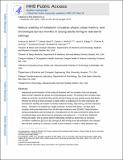Robust stability of melatonin circadian phase, sleep metrics, and chronotype across months in young adults living in real‐world settings
Author(s)
McHill, Andrew W; Sano, Akane; Hilditch, Cassie J; Barger, Laura K; Czeisler, Charles A; Picard, Rosalind W.; Klerman, Elizabeth B; ... Show more Show less
DownloadAccepted version (580.9Kb)
Open Access Policy
Open Access Policy
Creative Commons Attribution-Noncommercial-Share Alike
Terms of use
Metadata
Show full item recordAbstract
Appropriate synchronization of the timing of behaviors with the circadian clock and adequate sleep are both important for almost every physiological process. The timing of the circadian clock relative to social (ie, local) clock time and the timing of sleep can vary greatly among individuals. Whether the timing of these processes is stable within an individual is not well-understood. We examined the stability of circadian-controlled melatonin timing, sleep timing, and their interaction across ~ 100 days in 15 students at a single university. At three time points ~ 35-days apart, circadian timing was determined from the dim-light melatonin onset (DLMO). Sleep behaviors (timing and duration) and chronotype (ie, mid-sleep time on free days corrected for sleep loss on school/work days) were determined via actigraphy and analyzed in ~ 1-month bins. Melatonin timing was stable, with an almost perfect relationship strength as determined via intraclass correlation coefficients ([ICC]=0.85); average DLMO timing across all participants only changed from the first month by 21 minutes in month 2 and 5 minutes in month 3. Sleep behaviors also demonstrated high stability, with ICC relationship strengths ranging from substantial to almost perfect (ICCs = 0.65-0.85). Average DLMO was significantly associated with average chronotype (r = 0.53, P <.01), with chronotype displaying substantial stability across months (ICC = 0.61). These findings of a robust stability in melatonin timing and sleep behaviors in young adults living in real-world settings holds promise for a better understanding of the reliability of previous cross-sectional reports and for the future individualized strategies to combat circadian-associated disease and impaired safety (ie, “chronomedicine”). 2
Date issued
2021Department
Program in Media Arts and Sciences (Massachusetts Institute of Technology)Journal
Journal of Pineal Research
Publisher
Wiley
Citation
McHill, Andrew W, Sano, Akane, Hilditch, Cassie J, Barger, Laura K, Czeisler, Charles A et al. 2021. "Robust stability of melatonin circadian phase, sleep metrics, and chronotype across months in young adults living in real‐world settings." Journal of Pineal Research, 70 (3).
Version: Author's final manuscript